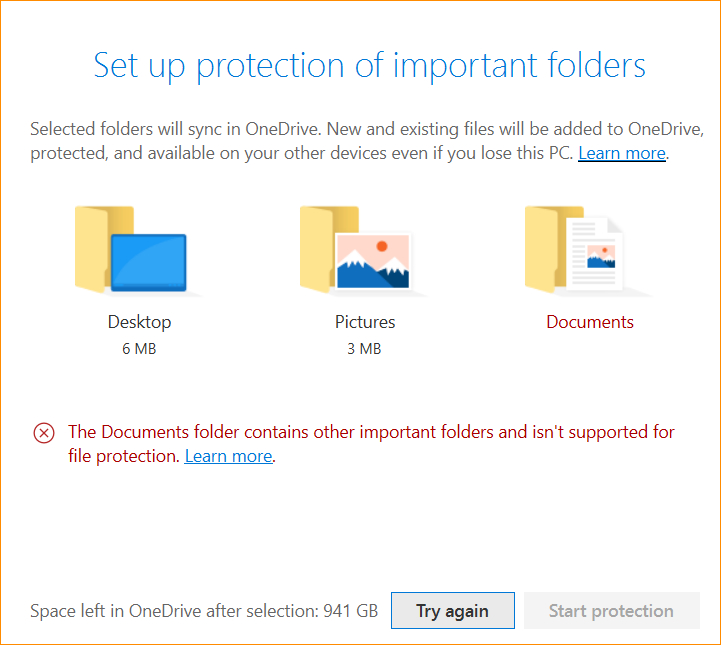Yet another dreaded hurdle trying to enable OneDrive “Backup” (previously labeled as KFM, or “Known Folder Move”). When trying to enable OneDrive backup, you get an error: “The Documents folder contains other important folders and isn’t supported for file protection.”

I’ve written about Onedrive’s temperamental attitude at least twice in the past. It seems that for the most part it either works right out of the box, or it fights you tooth and nail. In this case, one of my first OneDrive move attempts was still not working, and I was hell-bent on getting it fixed this time. When trying to enable Backup, I got the error mentioned above.
In this case, I tried the following:
- Tried emptying the entire contents of Documents into another folder, actually into the root of the C Drive.
- Verified there were no orphaned files in the $Recycle.bin, and sure enough there were. Still no bueno though.
- Verified the default location of the library was c:\users\(username)\Documents
- Even deleted, then re-created the actual Documents folder on the drive
As you can tell, I’ve thrown everything and the kitchen sink at this problem. I then pulled out the big guns and used Process Explorer to look at the drive access of Onedrive to try to see what it was looking at, and in doing so, I inadvertantly found that it was actually looking at the folder I moved all the Document contents into! The one on the root of C! Wow…how is it getting there?
As it turned out, this user’s profile was likely migrated over the years from possibly as far back as Windows XP (or 7). As such, the “My Pictures” library was actually pointed into the “My Pictures” folder in the Documents folder, instead of the more modern location of C:\users\(username)\Pictures. As such, this was triggering this error in OneDrive.
So Jeff: 4, OneDrive: 0, but here’s a list of all the OneDrive gotchas I’ve encountered trying to enable OneDrive backup/KFM. If you found any more, please leave a comment below!
- Folder redirection GPO/Group Policy; to undo a redirection policy, you have to not only remove or disable it, but you have to apply a DIFFERENT gpo to counter-act its behavior.
- Removal of “fix” GPO – Yeah don’t forget that once a redirected home drive has been finally redirected back, you still have to remove the “fix” GPO as well, as its also considered a redirection GPO.
- Orphaned Recycle Bin files: Emptying the recycle bin via the GUI should work in most cases; if you find the $Recycle.BIN folder still has contents after doing so, those files are orphaned and need to be manually removed.
- You can use Powershell for this, but note that to get into the $Recycle.Bin folder, use cd ‘$Recycle.bin’ (with the single quotes), as just doing cd /$Recycle.bin, or cd $Recycle.bin will NOT work.
- My Music / My Pictures libraries pointed into Documents folder – these should be defaulted back to their respective folders under the user’s root profile folder.
- To check this, go into an explorer window, right click on Pictures, go to properties, then go to the Location tab. It should say c:\users\(username)\Pictures. If it includes Documents, click the Restore Default button to fix it. Note that once OneDrive backup is enabled, this location will be changed to a folder within your OneDrive folder.
- OneNote files – as of the last year or so (perhaps 2019 forward?), OneDrive now supports moving OneNote files, so this shouldn’t be an issue anymore. Shouldn’t 😉
- Other unsupported files: PST files are a big gotcha with OneDrive; it doesn’t support these at all.
If you found any more, please leave a comment below!
